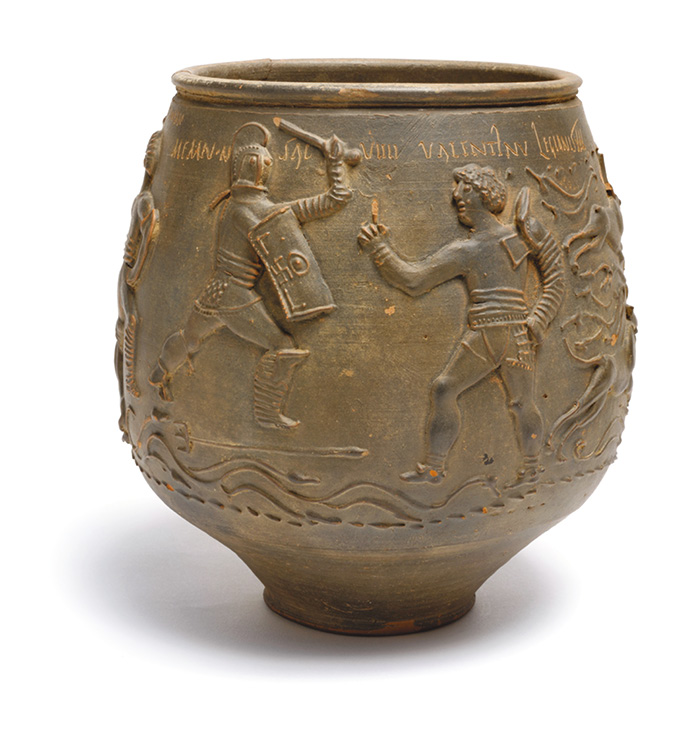
The ‘Colchester Vase’ is one of the most important, and perhaps famous, pots from Roman Britain. It was discovered in 1853 at West Lodge in Colchester and donated to the Museum by local antiquarian John Taylor.
The ‘Colchester Vase’ is one of the most important, and perhaps famous, pots from Roman Britain. It was discovered in 1853 at West Lodge in Colchester and donated to the Museum by local antiquarian John Taylor. The pot is a cremation vessel and was found buried alongside other ceramic grave goods dating to the late second century AD. It is a large colour-coated jar decorated with animals and figures in relief, a style known as barbotine. It has now been proven that this vessel was made in the pottery kilns of Colchester - a significant industry from the mid second century. The pot is decorated with a continuous frieze that can be divided into three scenes, relating to arena spectacles. From left to right: Firstly, two animal hunters (bestiarii/venatores), named Secundus and Mario, fight a bear. Secundus is barely clothed and holds a cudgel in each hand. Mario is better armoured, with leg and arm guards, and brandishes a whip at the bear that has turned its head towards him. In the next scene a pair of gladiators are depicted. Memnon, a well-armoured secutor gladiator, fights with a sword (gladius) and shield and wears the distinctive, encasing helmet. His opponent is Valentinus, a retiarius gladiator, identifiable by the trident (tridens or fuscina) which he has dropped to the ground, although he has lost his net (rete). He is lightly armoured with a padded arm sleeve (manica), his main protection being a distinct, tall metal guard on the left shoulder (galerus), which acted like a shield. Valentinus raises his index finger (ad digitum) signalling his defeat. Valentinus may have been at a disadvantage in that Memnon is depicted as left-handed (scaeva), one of only two depictions of such a fighting style known from Roman Britain. In the final scene of the pot’s decorative frieze, a hunting dog is shown in pursuit of two stags and a hare. The names of all the figures are specified in an inscription that runs around the top of the pot, below the rim. This inscription was cut onto the pot as it was being made (pre-firing). It records that this was Memnon’s ninth victory as a gladiator and that Valentinus was of the Thirtieth (XXX) legion in the Roman army. This last piece of information presents a puzzle as the Thirtieth legion was never stationed in Britain. Jocelyn Toynbee suggested that the Thirtieth legion may have owned a gladiatorial troupe to provide them with entertainment. Therefore, Memnon and Valentinus may have been well-known celebrity gladiators of their day. As part of Colchester Museums’ ‘Decoding the Dead' Project the cremated remains inside the Vase were analysed revealing the deceased was a 40+ year old, non-local, male.
Image :Colchester Museums